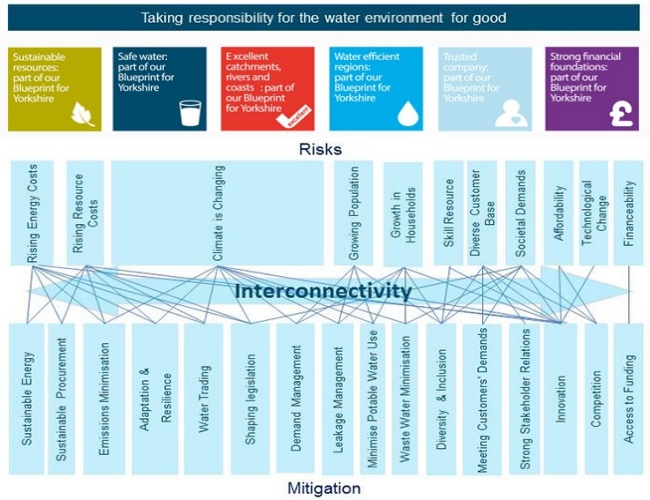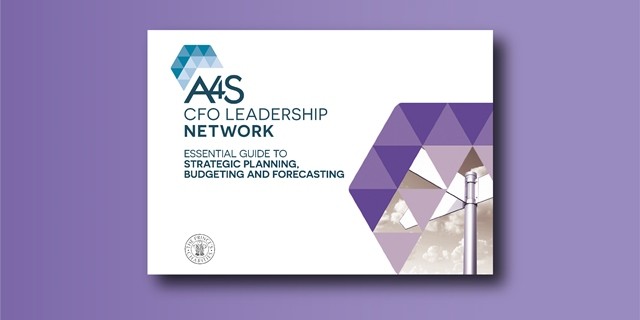Yorkshire Water: Strategic Planning, Budgeting and Forecasting
IDENTIFYING LONG TERM RISKS AND OPPORTUNITIES
Why did you undertake this exercise?
We wanted to understand fully the risks and opportunities the business was likely to face over the next 25 years, the necessary strategic responses and how they aligned to our vision and six Strategic Business Objectives. The approach taken can be illustrated through the three step process.
Step 1:What approach did you take in identifying key risks and opportunities?
We formed an internal cross business steering group (sponsored at Board level) to determine the key sustainability risks and opportunities using the PESTEL framework.
Why did you use PESTEL? |
It is a useful structure to explore fully our 'risk universe' over varying timescales. It ensures the Executive Team have visibility of risks from different perspectives and stakeholder views, and hence covers a whole range of issues and risk origins. |
What were the challenges with using PESTEL as the approach? |
Those involved have to be prepared to put in the time and effort to go through the structure in a disciplined manner. Often, debate covers more than one PESTEL area at the same time – it is not always easy to allocate risks to just one area so this can sometimes disrupt the flow of the workshop and make note taking difficult! |
What were the benefits of using PESTEL? |
The structured approach ensures all areas are covered, generates debate, allows the process to move on naturally through each area, and provides a starter for open discussion. It is an easy format to use in a workshop style with an Executive Team, quick, straightforward and generates information to explore in more detail. |
What was the outcome of the exercise and what is next? |
We produced a view of all the risks and opportunities likely to impact our strategic business objectives over longer time horizons including those from external sources (rather than internally driven). This then allowed us to explore likely scenarios and develop appropriate annual and five yearly goals. The output is a sustainability plan to respond to these risks and opportunities (all logged within our risk register) which is wholly integrated into our corporate strategy. |
Step 2: How did you further understand how these risks and opportunities are likely to impact your business?
We aligned the risks and opportunities to our strategic risk register and considered appropriate mitigation. The approach identified that further information was needed regarding the uncertainty associated with some of the risks and opportunities that the business would face over the next 25 years. We worked with external sustainability experts to develop evidence based forecasts of what the world (specifically Yorkshire and the UK) could look like in 25 years and the key stages of change between then and now.
Risks and opportunities that are more short term and known are included within our risk register and are assessed, both qualitatively and quantitatively, within a scoring matrix. This establishes whether the risk or opportunity is material (against risk appetite determined by our Executive Team) and the level of control. Our Internal Audit function provides assurance over the effectiveness of the controls.
Step 3: How did this approach inform your business decisions?
Forecasting key risks and opportunities provided an insight to the changing nature of the water sector over the next 25 years. On the back of this work, objectives and targets that are aligned with our business plans, and scorecards were set for milestone years towards longer term outcomes to 2040.
Our objectives and targets are a mix of short to medium term through to the aspirational, where the way in which they will be achieved is yet unknown. An example of an aspirational objective is our ambition for ‘global safe water’ which has led to a partnership with WaterAid in Ethiopia.
What challenges did you face?
The key challenge was to ensure that the sustainability strategy didn’t exist as a separate piece of work but was integrated into the company strategy. This required Board level buy-in to the concept, the work, objectives and targets that the company was signing up to, especially where these were outside of our regulatory contract.
What is next for your organization?
We periodically update our long term analysis to ensure our evolving strategy is always based on latest available evidence. In our latest assessment we found the same trends shaping our business, but with some critical changes to the expected rate of change, for example with even quicker developments in technology than previously forecast.
Ensuring the long term focus remains embedded at the heart of our strategy and business model is an ongoing process. As a part of mitigating long term risk, we manage a programme of activity to help us prepare for the identified opportunities and threats. We discuss regularly with our Board and Executive Team our strategy and progress against this programme of mitigation activity, and we openly report on our strategy, business model and risk management through our integrated Annual Report and Financial Statements.
Why did you choose a 25 year timescale?
A 25 year timescale was chosen because it allows the short term business planning to be set in the context of a long term direction (not constrained by, for example, the current regulatory framework or customer base). We wanted to understand, for example, what our customers might expect from us in 10 years’ time, what skills there might be in the talent pool in Yorkshire, and how raw material costs might affect our business in the future.
What challenges did you face?
The key challenge was to ensure that the sustainability strategy didn’t exist as a separate piece of work but was integrated into the company strategy. This required Board level buy-in to the concept, the work, objectives and targets that the company was signing up to, especially where these were outside of our regulatory contract.
What is next for your organization?
We periodically update our long term analysis to ensure our evolving strategy is always based on latest available evidence. In our latest assessment we found the same trends shaping our business, but with some critical changes to the expected rate of change, for example with even quicker developments in technology than previously forecast.
Ensuring the long term focus remains embedded at the heart of our strategy and business model is an ongoing process. As a part of mitigating long term risk, we manage a programme of activity to help us prepare for the identified opportunities and threats. We discuss regularly with our Board and Executive Team our strategy and progress against this programme of mitigation activity, and we openly report on our strategy, business model and risk management through our integrated Annual Report and Financial Statements.




